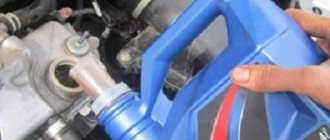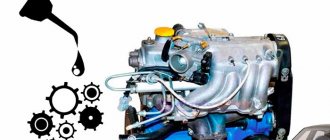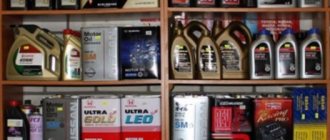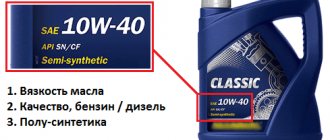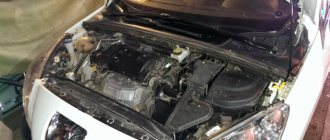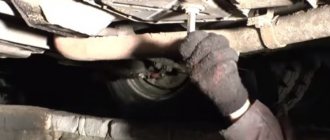The other day, on the eve of a trip to the sea, I changed the engine oil. I change the oil approximately every 10,000 km. I do everything myself, because... there is nothing complicated there. And besides, it seems to me that if you change the oil somewhere at a service center, they won’t completely drain it anyway, because... they need to do work faster in order to get more done and, accordingly, earn more (as they say, nothing extra - just business). For consumables I use:
1. Oil filter MANN (article W753), or MAHLE (article OC467). I use these manufacturers because... their valve always works correctly (if it’s not a fake, of course). The operation of the valve means that when you start the car when it is cold, the oil pressure lamp goes out almost instantly after starting the internal combustion engine (unfortunately, this does not happen with all oil filter manufacturers). This means that after parking the car with the engine turned off, the oil from the filter does not flow into the sump and, upon startup, is immediately supplied to the oil system, thereby minimizing wear. But the main wear and tear of a serviceable internal combustion engine occurs precisely during a cold start! This time I used MANN.
2. O-ring for the Sasic pan plug (part number 1640540). I use Sasic because on many French cars (including here) it comes from the factory in the original. The ring must be changed every time the oil is changed.
3. Sasic pan plug (article 1630210). I always change the cork purely out of convenience and laziness to wash my hands again. When unscrewing the old plug, I don’t try to fish it out from under the stream of old hot oil - it just falls into the drain container for the old oil. At the same time, your hands remain clean and without burns, because... Do not douse yourself with old hot oil. The price for such convenience is only 25 rubles. Acceptable for me))))
About the Lada Largus model and its engine
Largus belongs to the small class station wagons, built on the B0 platform. This is the same Dacia Logan MCV, only completely adapted to the realities of Russian roads and operating conditions. It has been successfully produced by Tolyatti residents for 7 years and does not lose popularity among consumers.
Largus is available in three variations: 5- and 7-seater station wagons, as well as a van designed for two people, including the driver.
All three modifications can be equipped with two powertrain options:
8 “boiler”, 1.6 l and 87 hp. (K7M) - developed by AvtoVAZ specialists;
16-valve, 1.6 l, 102 “horses” (K4M) – developed by Renault-Nissan specialists.
Elf Evolution SXR 5w30
The latest synthetic product of very high quality. Belongs to the group of all-season oils. Thanks to unique additives, the oil increases the life of the internal combustion engines of Renault cars. The lubricant is fully adapted to work in any climatic zone, its properties remain unchanged in extreme conditions.
- Significantly extends the life of the engine, increases its power and the time period for a complete oil change;
- Has temperature stability and excellent anti-oxidation characteristics;
- Reduces the friction force that occurs between rubbing surfaces and, as a result, wear of parts;
- Unique detergent additives keep engine system elements clean.
With this oil, the car receives reliable protection from any unforeseen circumstances.
What to look for when choosing
Before pouring oil into the Lada Largus, you need to remember that no matter what lubricant is used, there is no fundamental difference in the number of valves - it “works” equally well on both engine options.
Therefore, first of all, it is necessary to decide on the composition. This definition depends on the operating mode of Largus. If the car will be used daily, then it is worth pouring into such a car oil created on the basis of conventional or hard hydrocracking.
In simple terms, we are talking about synthetic lubricant and semi-synthetic lubricant, respectively. You can also use mineral oil, but you will have to change it more often.
If Lada Largus is driven at high speeds, then it is necessary to use lubricants based on esters or PAO. As for mineral oils, they are completely unsuitable for such operating modes.
What kind of oil and in what volume is poured into the Largus engine
It should be noted that this car uses five engines:
- 8 valve - VAZ-11182;
- 8 valve – VAZ-11189;
- 8 valve – K7M;
- 16 valve – K4M;
- 16 valve – VAZ-21129.
Each engine has its own crankcase volume. In this case, the manufacturer pours the same oils into all engines of the same manufacturer. In this case, arguing about which oil is better for Largus is pointless. However, there are several good options:
| Engine | Number of valves | Crankcase volume | Oil |
| VAZ-11182 | 8 | 3,5 | ROSNEFT Premium, ROSNEFT Maximum 5W-40, Lukoil Genesis RN 5W-40 |
| VAZ-11189 | 8 | 3,5 | ROSNEFT Premium, ROSNEFT Maximum 5W-40, Lukoil Genesis RN 5W-40 |
| VAZ-21129 | 16 | 4,4 | ROSNEFT Premium, ROSNEFT Maximum 5W-40, Lukoil Genesis RN 5W-40 |
| K7M | 8 | 4,8 | Elf Solaris RNX 5W-30, Castrol |
| K4M | 16 | 3,3 | Elf Solaris RNX 5W-30, Castrol |
According to the passport, the volume of the VAZ 21129 crankcase is 3.5 liters. But paired with a box from Renault, its volume increases, as an empty cavity appears as a result of using the adapter plate.
The table shows the brands of motor oils that the manufacturer pours into its engines within the walls of the enterprise. These same liquids are used when visiting a dealership. However, it is not prohibited to pour the following brands of oils:
- Shell Helix Ultra 5W40;
- Mobil;
- MANNOL ENERGY JP 5W-30;
- Shell Helix HX-8;
Domestic engines are less sensitive to fluid quality, unlike their counterparts from France. Therefore, they are able to digest even low-grade domestic oils and are not afraid of counterfeits.
In addition to the engine oil, you must select the appropriate filter. The articles are as follows:
| VAZ engines | 21080-1012005-00; 21080-1012005-08; 21080-1012005-09. |
| Renault engines | 7700274177 |
After this, you can start changing the lubricant in the engine.
Tips from Largus owners
Thanks to its unpretentiousness, Lada Largus is able to “work” on any of the oils on the market.
In order for the engine to operate as long as possible, it is necessary to change the lubricant a little more often than indicated in the regulatory documentation - approximately every 8 thousand kilometers. This will allow the lubricant to protect engine parts from excessive wear.
And the market is now simply teeming with proposals, both from well-known brands and from “Chinese” analogues. The main condition is not to fall for a fake, as it can have a detrimental effect on the engine.
In order not to buy a “pig in a poke”, you need to purchase lubricants for Largus only from trusted sellers and avoid cheap offers. If you follow these recommendations, the “goose” motor (as Largus is popularly called) will last a long time.
Types of oils
- Synthetic is a high-quality oil with continuous advantages. This is a very fluid and liquid composition that is not afraid of low temperatures. An ideal option for any modern vehicle, including Lada Largus. It has good extreme pressure and anti-oxidation properties, and also effectively cools engine components and thereby prevents overheating. Synthetics have proven themselves well in all temperature and road conditions. This oil will last for a long time, and this will have a beneficial effect on the frequency of replacement.
- Semi-synthetic – a mixture of synthetic and mineral oils. There is much more of the latter (70% of the total volume), and yet this composition is much better than “mineral water”. It withstands low temperatures better, as it practically does not freeze in frosty weather. Semi-synthetics are a worthy alternative to mineral oil.
Next, we will consider the best brands, as well as oil parameters, tolerances and standards separately for each year of production of Lada Largus:
Year of manufacture – 2012
SAE parameters:
- All-season – 10W-40, 10W-50, 15W-40, 5W-40
- Winter – 0W-40, 5W-40, 5W-50
- Summer – 20W-40, 25W-40, 25W-50
API Standard:
- Gasoline engines – SM
- Type – synthetic, semi-synthetic
- The best companies are Shell, Castrol, Mobile, ZIK, Lukoil, Gt-Oil, Valvoline, Xado
Year of release – 2013
SAE parameters:
- All-season – 10W-50, 15W-40, 5W-40
- Winter – 0W-40, 5W-50
- Summer – 20W-40, 25W-50
API Standard:
- Gasoline engines – SN
- Type – synthetic
- The best brands – Mobile, Castrol, Shell, Xado, Lukoil, ZIK, Gt-Oil, Valvoline
Year of release – 2014
SAE parameters:
- All-season – 10W-50, 15W-40, 15W-50
- Winter – 0W-40, 0W-50
- Summer – 20W-40, 25W-50
API Standard:
- Gasoline engines – SN
- Type – synthetic
- The best brands are Castrol, Shell, Mobile, ZIK, Xado.
Technical features of K4M
The monolithic cylinder block of the Renault K4M engine is made of cast iron. It has an in-line arrangement of four cylinders. The piston group is reinforced with steel inserts in the area where the compression rings are installed. The fixing piston pins are pressed tightly into the upper heads of the connecting rods, and are installed in the piston bosses with a gap. The piston weight is 450 grams, with a diameter of 79.465 - 79.475 and a compression height of 31.7 mm. The internal combustion engine uses forged steel connecting rods with the following dimensions (mm):
- 128 – length
- 47.612 – 47.627 – bottom head hole diameter
- 19.945 – 19.958 – diameter of the upper head hole.
K4M without valve cover
The cylinder head is made of aluminum. A belt is used to drive the timing mechanism. The engine is equipped with sixteen valves and two lightweight steel camshafts. Cams are pressed onto them.
The intake and exhaust valve plates are manufactured with a diameter of 32.5 and 28 mm, respectively. The length of the rods in millimeters is:
Pistons with connecting rods K4M
In this case, the diameter of the rods is the same and equals 5.5 mm.
Compliance with the established criteria for environmental standards is ensured through the use of a phase regulator.
Video review of the VAZ 21129 1.6 l 16 valve engine from Lada Largus
Firstly, the 21129 engine is a modified version of the 21127, which differs primarily in toxicity standards. 21129 is adjusted to EURO-5 toxicity standards in order to obtain approval under current legislation.
Secondly, the compression ratio has been changed. 21129 the engine was literally “unclamped” to make it possible to use AI-92 class fuel. The 127 engine did not have this option.
Thirdly, the 129 1.6 Lada Largus engine with 16 valves has a modified intake and exhaust, which has a positive effect on the dynamics of the car.
Fourthly, the 129 motor runs under a new engine control unit with a modified program.
Fifth, the engine mounts have been modified to reduce vibration from the powertrain.
And this is just a small part of the changes that affected engine 21129. In fact, there were much more, but alas, many, seeing that the engine is similar in appearance, think that no changes were made. If we dig deeper, we will see that the piston rings have become thinner and the piston has become lighter. This was done to reduce friction and increase engine life, as well as improve the overall performance of the engine.
Tuning
To increase the power of the Renault K4M engine up to 120 horsepower, you can do chip tuning. This will require:
- install an exhaust system without a catalyst
- mount drivetech 10 phase 270 camshafts.
K4M cylinder head without cover
To achieve higher power levels, significant modernization of the K4M engine will be required. Tuning can be done using a PK-23 compressor or a TD04 turbine.
Using the first option, you can get power ranging from 140 to 150 hp. The boost pressure should not exceed 0.5 Bar, due to the low compression ratio of the K4M engine. You will also need to make a custom kit; there are no ready-made solutions. You will need to install a direct-flow exhaust, camshafts (phase 270-280), an Abit ECU and injectors, suitable from the Volga.
The second option for tuning the K4M engine is identical, except for the use of a turbine. Its implementation will make it possible to achieve a power of slightly more than 150 hp.
K4M under the hood of Nissan Almera G15
Service
Maintenance of the K4M engine consists of timely replacement of consumables. They change with the following frequency, expressed in kilometers:
K4M from the side of timing belts and attachments
- 15000 – engine oil, oil and air filter
- 30000 – spark plugs
- 60000 – replacement of the attachment belt and timing belt
- 90,000 – from the moment of purchase, then the coolant is changed every 60 thousand.
After another fifteen thousand kilometers, you should check the condition of the attachment belt, as well as the tightness of the cooling system and exhaust gas circuits. Adjustment of valves on the K4M power unit is not required, since there are hydraulic compensators.
Set of spare parts for changing the K4M timing belt
How to replace the oil filter
You will need: a 10" or 13" wrench, a puller or a screwdriver.
On the K4M engine, access to the oil filter is blocked by the engine protection, which will have to be removed (6 x 10 screws). Or remove the fuel frame protection from above by unscrewing the 2 “13” screws. Place an empty container under the filter and turn it counterclockwise using a puller.
If you don’t have a special tool, you can use a screwdriver. For easier access to the filter on the K7M engine, you can remove the exhaust manifold thermal shield by unscrewing the three mounting screws. Then pierce the filter housing with a screwdriver (closer to the bottom of the filter, so as not to damage the motor fitting), unscrew the filter, using the screwdriver as a lever.
Fill the new filter 1/3 full with new engine oil and lubricate the sealing ring with it. Then install the oil filter, tightening it by hand until the O-ring comes into contact with the cylinder block. After this, tighten the oil filter another 3/4 turn.
Articles (must read!)
The plug is unscrewed from the bottom of the crankcase. It is supplied with a washer. These parts are not sold as a set, only individually.
The article number of the plug is 7703075348. We were able to find three articles for the washer: 110265505R, 8200641648, 7703062062. In the latter case, it will just be a copper ring.
The washer can be made from a sheet of copper. The internal diameter should be 16.7 mm. If the dipstick is lost, it’s not a problem. Use article number 8200666287.
Selection of analogues
Firstly, the drain plug has alternative part numbers - 7703075210, 7703075347, 7903075033. Analogs for it:
- CORTECO 220100S
- BMW 07119919143
- METALCAUCHO 05655 or 00667
- SASIC 1630210
- NISSAN 1112800Q0A or 1112800QAA
- ASAM 80102 or 30385
- CITROEN 16393 or 2221 11
- OPEL 4433916 or 4418098
- FEBI 45890
- FA1 539.970.011 or 518.471.001
The washer with a rubber band also has analogues:
- GECKO GKFLM507
- SASIC 1640540 or 4001073
- DELLO 3011020655005R
- CITROEN 16488
- VICTORREINZ 703376900
- MANOVER MRLOGAN8853 or MRLOGAN7612
- CORTECO 006339S
- PPS 21431867
- FEBI 44793
- DT 2.10221
- AJUSA 502300
- VAICO V460562
- MERCEDES-BENZ
- SCANTECH 5321867
Filter part numbers can be found in other text.
Disadvantages and weaknesses of K4M
When operating the Renault K4M engine, the following disadvantages occur:
- Poor-quality ignition coils - their breakdown leads to the fact that the power plant begins to trip. The first thing to check is the spark plugs, but more often than not, the problem lies in one of the ignition coils.
- Unstable speed - can occur due to many reasons, but most often floating speed occurs due to a dirty throttle valve, air leaks from the throttle assembly, or failed sensors.
K4M cylinder block
- Unreliable phase regulator - very often the device breaks down even before the end of the warranty period.
- Coolant and oil leaks - weak points for leakage are the pump, crankshaft oil seal and cylinder head gasket.
- Failure of the crankshaft pulley due to destruction of the damper spring. The problem is observed on Spanish-assembled engines.
A broken timing belt is accompanied by bending of the valves as a result of contact with the pistons. The problem manifests itself in winter due to design flaws. Snow swept into the engine compartment settles on the protective casing of the gas distribution mechanism. Subsequently, it melts, and water falls on the lower part of the belt. After stopping the car, the accumulated moisture sets in, which leads to the belt slipping when starting a cold power plant.
Crankshaft K4M
Also, among the disadvantages of the Renault K4M engine, we highlight:
- deterioration in performance when using low-quality AI-92 gasoline (the engine cannot be blamed for this)
- low traction, which is not enough for confident overtaking
- high price and low availability of spare parts.
Comments
TOP materials
Products in the store
Lada.Online
Lada (“Lada”) is a brand of cars produced by AvtoVAZ JSC. Previously, it was used only for export cars, and for the domestic market, cars were produced under the Zhiguli brand. In 2004, the management of AvtoVAZ announced the transition to the Latin alphabet for the official spelling of the names of all cars produced by the plant: Lada - instead of "VAZ" and "Lada".
Lada.Online is the largest Russian-language automotive resource with a daily audience of thousands, which is dedicated primarily to cars of this brand, the domestic automotive industry and the automotive world in general.
This site is not the official LADA website.
2020 Lada.Online. Copying of material is permitted only with a link to the source.
